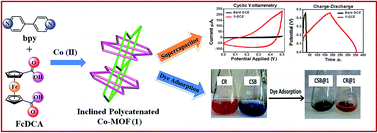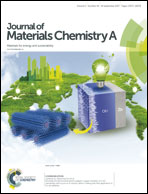Design and construction of a ferrocene based inclined polycatenated Co-MOF for supercapacitor and dye adsorption applications†
Abstract
A new cobalt based inclined polycatenated metal–organic framework, {[Co4(FcDCA)4(bpy)4(H2O)6]·11H2O}n [FcDCA = 1,1′-ferrocene dicarboxylic acid and bpy = 4,4′-bipyridyl] (1), has been designed and synthesized in a facile manner. 1 can be simplified as a 2D + 2D → 3D inclined polycatenation class with Doc1/1, as authenticated by single crystal X-ray studies. Further, 1 was employed as a modifier for a glassy carbon electrode (1-GCE) without using any binders to explore its supercapacitor performance. Detailed electrochemical investigations carried out using 1-GCE reveal a specific capacitance of 446.8 F g−1 at a current density of 1.2 A g−1, with an excellent cycle life of ∼88.37% (after 800 cycles). Moreover, a high rate performance was also observed for 1-GCE (it retains 81% of its initial capacitance up to a high current density of 10 A g−1), which endorsed its good stability on the electrode surface. The results were found to be superior than those for {[Co(bpy)1.5(NO3)2]}n (2), highlighting the role of the presence of FcDCA in 1. Additionally, the notable adsorption and desorption properties of 1 towards selected Chicago Sky Blue (CSB) and Congo Red (CR) dyes confirms the candidature of 1 as a potential dye adsorbing agent.



 Please wait while we load your content...
Please wait while we load your content...